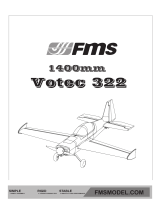
Introductions
Contents of Kit
Assemble the plane
Install the battery and Radio installation
Get your model ready to fly
The transmitter and model setup
Check the control throws
Clevis Installation
Control Horn and Servo Arm Settings
Install the propeller and spinner
Center of Gravity(CG)
Before flying the model
Flying course
Trouble shooting
Spare parts list content
ESC instruction
Table of Contents
Introductions
The Hawker Typhoon, was a British single-seat fighter-bomber, produced by Hawker Aircraft. When the
Luftwaffe brought the formidable Focke-Wulf Fw 190 into service in 1941, the Typhoon was the only RAF
fighter capable of catching it at low altitudes; as a result it secured a new role as a low-altitude interceptor.
From late 1942 the Typhoon was equipped with bombs and from late 1943RP-3 ground attack rockets were
added to its armoury. With those weapons and its four 20mm Hispano cannon, the Typhoon became one of
the Second World War's most successful ground-attack aircraft.
Take to the skies with one of FMS’s latest offerings, the Hawker Typhoon 1100mm PNP! This scale 1100mm
wingspan warbid is a sight to behold. Reinforce wing surfaces allow flyers to perform advanced maneuvers
like point rolls, barrel rolls, Immelmanns, half-Cubans, and split S with ease. Retractable landing gear,
3-blades prop with spinner, and spit flaps all add to the realism of this incredible model. This plane has the
power, detailed features, and durability that discerning flyers will appreciate, if you are looking for a British
warbirds fighter, this is a great choice for you.
FEATURES:
* Realistic scale features including WWII RAF paint scheme, hand painted pilot figure, gun turrets, and
* The latest high-ratio foam, which lightens the airplane's weight.
* Servoless electronic retractable landing gear
* New structure optimizes the performance.
* Scale 3-blade propeller
* Portable wingspan
* Split flap
3
···················································································································································3
················································································································································4
········································································································································5
········································································································8
···························································································································9
····················································································································9
······························································································································10
··········································································································································11
···········································································································11
····················································································································12
···································································································································12
·································································································································13
················································································································································14
···········································································································································15
·································································································································16
············································································································································17
molded panel lines




























